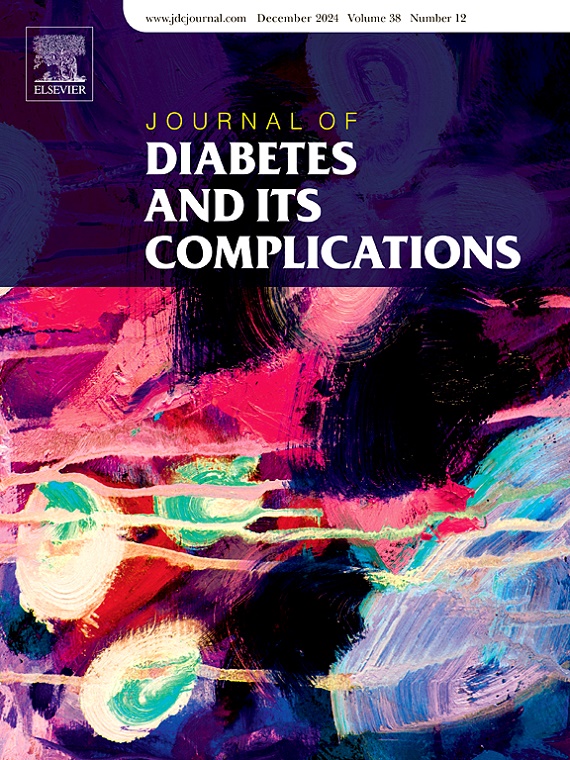使用辅助混合闭环治疗与传感器增强泵治疗的个体在妊娠期间胰岛素泵设置的变化
IF 2.9
3区 医学
Q3 ENDOCRINOLOGY & METABOLISM
引用次数: 0
摘要
目的:比较1型糖尿病患者在妊娠和产后早期使用传感器增强泵治疗(SAPT)或混合闭环治疗(HCL)时胰岛素泵设置和胰岛素分布的变化。方法在这项研究者发起的试验中,23名参与者在妊娠14-18周随机接受HCL治疗或SAPT治疗,直到产后4-6周。我们使用混合效应模型比较了组间胰岛素泵设置和胰岛素输送的变化。结果从孕前到产后4-6周,HCL组和SAPT组每日胰岛素总剂量无显著差异。然而,在第9个月,HCL组总胰岛素来自胰岛素丸的比例更高(70.9% HCL vs 57.9% SAPT, p = 0.014)。与SAPT相比,HCL组在第9个月和第10个月的日基础总剂量较低(p <;与SAPT组相比,第10个月的总日剂量更高(55.2单位/天vs 37.1单位/天,p = 0.025)。泵设置的改变次数在两组之间没有差异。从妊娠第9个月到产后早期,HCL组几乎所有时间点的胰岛素活性时间都明显缩短。在妊娠期,HCL组的早餐(p = 0.020)和午餐(p = 0.005)的碳水化合物与胰岛素比率更强。结论与SAPT组相比,HCL组使用了更多的胰岛素量和更少的基础胰岛素,至少部分原因是泵设置有助于更多的胰岛素量输送。本文章由计算机程序翻译,如有差异,请以英文原文为准。
Changes to insulin pump settings throughout pregnancy for individuals using assisted hybrid closed-loop therapy versus sensor-augmented pump therapy
Aims
We compared changes in insulin pump settings and insulin distribution throughout pregnancy and early postpartum for participants with type 1 diabetes using sensor-augmented pump therapy (SAPT) or hybrid closed-loop (HCL) therapy without a pregnancy-specific glucose target.
Methods
In this investigator-initiated trial 23 participants were randomized at 14–18 weeks gestation to HCL therapy or SAPT until 4–6 weeks postpartum. We compared the changes to insulin pump settings and insulin delivery between groups using mixed-effects models.
Results
There were no significant differences in total daily insulin dose between HCL and SAPT groups from preconception through 4–6 weeks postpartum. However, the proportion of total insulin coming from bolus insulin was higher for the HCL group in month 9 (70.9 % HCL vs 57.9 % SAPT, p = 0.014). The HCL group had a lower total daily basal dose compared to SAPT in months 9 and 10 (p < 0.05 for both) and a higher total daily bolus dose at month 10 compared to the SAPT group (55.2 units/day vs 37.1 units/day, p = 0.025). The number of changes to pump settings did not differ between groups. Active insulin time was significantly shorter in the HCL group at almost all time points through month 9 of pregnancy and early postpartum. Carbohydrate-to-insulin ratios were stronger for breakfast (p = 0.020) and lunch (p = 0.005) over gestation in the HCL group.
Conclusion
More bolus insulin and less basal insulin were used by the HCL group compared to the SAPT group, at least in part due to pump settings that contribute to more bolus insulin delivery.
求助全文
通过发布文献求助,成功后即可免费获取论文全文。
去求助
来源期刊

Journal of diabetes and its complications
医学-内分泌学与代谢
CiteScore
5.90
自引率
3.30%
发文量
153
审稿时长
16 days
期刊介绍:
Journal of Diabetes and Its Complications (JDC) is a journal for health care practitioners and researchers, that publishes original research about the pathogenesis, diagnosis and management of diabetes mellitus and its complications. JDC also publishes articles on physiological and molecular aspects of glucose homeostasis.
The primary purpose of JDC is to act as a source of information usable by diabetes practitioners and researchers to increase their knowledge about mechanisms of diabetes and complications development, and promote better management of people with diabetes who are at risk for those complications.
Manuscripts submitted to JDC can report any aspect of basic, translational or clinical research as well as epidemiology. Topics can range broadly from early prediabetes to late-stage complicated diabetes. Topics relevant to basic/translational reports include pancreatic islet dysfunction and insulin resistance, altered adipose tissue function in diabetes, altered neuronal control of glucose homeostasis and mechanisms of drug action. Topics relevant to diabetic complications include diabetic retinopathy, neuropathy and nephropathy; peripheral vascular disease and coronary heart disease; gastrointestinal disorders, renal failure and impotence; and hypertension and hyperlipidemia.
 求助内容:
求助内容: 应助结果提醒方式:
应助结果提醒方式:


